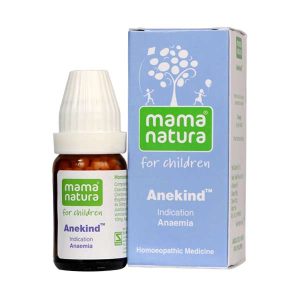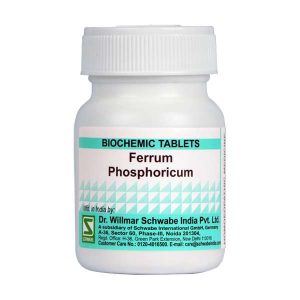
Anaemia
-
-18%
 Rated 5.00 out of 5 based on 1 customer rating(1)
Rated 5.00 out of 5 based on 1 customer rating(1)₹130.00₹106.60 You Save: ₹23.40 (18%)Add to cart -
-18%

-
-18%

Showing all 3 results
Anemia is a medical condition that is measured either according to the number of healthy red blood cells in the body or the amount of hemoglobin. In either circumstance, the cells will not get enough oxygen as it demands. It happens when the number of healthy red blood cells in your body is reduced. The hemoglobin is the protein within red blood cells that carries oxygen from the lungs to the tissues of the body. The hemoglobin is the main part of Red blood cells. Red blood cells carry oxygen to all of the tissues and organs of the body. Thus a low red blood cell count shows that the amount of oxygen in the blood is lower than it should be. Anemia can affect anyone. Anemia especially affects women, young children, and people with chronic diseases such as cancer are at the highest risk of developing anemia. The prime symptoms of anemia -are fatigue or pain. These symptoms appear because of ischemia, which is decreased oxygen delivery to the body’s vital tissues and organs. The organs do not get a sufficient amount of oxygen to work, and thus the symptoms appear.
Symptoms of Anemia:
The signs of anemia can range from mild to intense. At first, you might not even notice them. But they are pretty apparent as the disease progresses and becomes worse. Symptoms of anemia generally include:
- Dizziness
- Unusual heartbeat or heart murmur
- Increased pulse rate
- Headache
- Fatigue
- Pain, including in your bones, joints, chest, belly
- Problems with the growth of children and teens
- Discomfort while breathing
- Skin tone changes to pale or yellow
- Swollen or cold hands and feet
- Tiredness or weakness
- Irritability in behavior
- Unusual cravings, such as wanting to eat ice, clay, or dirt
- Trouble concentrating or tiredness
- Constipation
- Jaundice
- Enlarged lymph nodes
- An enlarged spleen or liver
- Atrophic glossitis of tongue resulting in a smooth, glossy, red, and often painful Inflamed tongue
- Brittle nails
- High or low blood pressure
- Vision problems
People suffering from chest pains or fainting, along with other signs or symptoms of anemia, should seek immediate medical attention.
Anemia Types and Causes:
Anemia is a blood disorder that can affect people of different ages, races, and ethnicities. Various types of anemia are known today. Some are very common, and some are very rare. With all having different causes and treatments. Starting from mild anemia during pregnancy, which is without any significant concern to some severe types of anemia that may create lifelong health troubles.
The types of anemia are numerous. Anemia is majorly classified into the following three groups:
- Anemia induced by blood loss
- Anemia induced by decreased or faulty red blood cell production
- Anemia induced by the destruction of red blood cells
What are the grounds to declare a person suffering from anemia? Anemia occurs if the body undergoes thorough one of the following changes: either the body makes too few red blood cells, destroys too many RBCs, or loses too many RBCs. RBCs contain a protein called hemoglobin that carries oxygen throughout the systems of the body. When there is a lack of RBCs, or the amount of hemoglobin in the blood is low, your body deprives of all the oxygen it needs. As a consequence, a feeling of tiredness or lethargy is experienced. You may also have other symptoms of anemia.
Factors that decrease red blood cell production causing anemia, typically include
- Inadequate stimulation of red blood cell production by the hormone erythropoietin, (produced by the kidneys)
- Deficiency of iron, vitamin B-12, or folate due to inadequate dietary intake
- Hypothyroidism
On the other hand, factors that increase red blood cell destruction may include any disorder where RBS destruction is higher than its production. And thus, it justifies the symptoms of anemia. Hemorrhaging is typically the reason which can happen because of:
- Accidents
- Endometriosis
- Gastrointestinal lesions
- Menstruation
- Childbirth
- Excessive uterine bleeding
- Surgery
- Cirrhosis, which involves scarring of the liver or other disorders of the liver and spleen
- Fibrosis (scar tissue) within the bone marrow
- Hemolysis can occur with some medications or Rh incompatibility
- May include genetic disorders such as:
- Glucose-6-phosphate dehydrogenase (G6PD) deficiency
- Thalassemia
- Sickle cell anemia
Even so, iron deficiency is the prime cause of anemia. It is held responsible for nearly more than half of all anemia cases. It is a leading nutritional disorder all over the world.
Diagnosis of anemia:
A diagnosis of any disease typically begins a physical exam. In the case of anemia, the physical exam is accompanied by brief health history and which is usually followed by family health history. The physician may suggest some laboratory tests. Laboratory tests often help doctors to find out the root cause of the anemia.
Tests to diagnose anemia may include the following :
- Complete blood count, aka CBC, serum iron levels, ferritin test, vitamin B-12 test, test to reveal folate levels in the blood called Folic acid test, Stool test for occult blood.
- Additional tests may include an upper GI ultrasound, a barium enema, a chest X-rays
- Or a CT scan of your abdomen
Anemia treatment
The treatment for anemia entirely depends on its causative factor, the type, and the severity of the condition. The treatment methods may include light changes in diet or supplements, medicines, to procedures like surgery to treat blood loss.
The prime objective of anemia treatment is to increase and maintain the amount of oxygen in your blood cells. Secondly, to treat the subjacent cause of the anemia. The purpose of the anemia treatment is to increase the red blood cell count or the hemoglobin level in the body to meet the oxygen demand.
Low levels of iron or vitamins in the body can be the cause of some types of anemia. Poor diet or certain diseases or conditions can be the reason behind these low levels of vitamins and iron. Following dietary changes and supplements can aid in the improvement of anemia:
To raise the standard levels of the vitamin or iron in the body, your doctor may ask you to change the diet you already are consuming. He may also advise you to add vitamin or iron supplements. Common vitamin supplements are folic acid and vitamin B12, Vitamin C (help the body absorb iron).
Iron
Iron to required by the body to make hemoglobin. Low levels of iron in the body are responsible for iron deficiency anemia. The most abundant source for iron is meat than vegetables or other foods. To treat anemia, your doctor may advise adding meat—especially red meat like beef or liver, chicken, turkey, pork, fish, and shellfish.
And if you are vegetarian, iron-rich food that is mostly advised in your meal plan include:
- Green leafy vegetables, spinach, peas, lentils, tofu; soybeans, and chickpeas, white, red, and baked beans,
- Dried prunes, raisins, and apricots
- Iron-fortified cereals and bread
Excess of anything, including iron, can be harmful, so take iron supplements only as your prescribed by your doctor.
Vitamin B12
Low levels of vitamin B12 leads to pernicious anemia. Therefore, vitamin B12 supplements are used in such a case. Foods rich in vitamin B12 such as soy-based beverages fortified with vitamin B12, cereals, meats like beef, liver, poultry, and fish, eggs and dairy products like milk, yogurt, and cheese,
Folic Acid
Folic acid (folate) is a form of vitamin B. Like vitamin B. It is also found in foods. Folic acid is demanded by the body to make and maintain new cells. It is crucial for women, especially during the period of gestation. It helps pregnant women to void the symptoms and, thus, in anemia treatment. As good as for pregnant women, it also promotes the healthy growth of the fetus inside the mother’s womb.
Food sources of folic acid include Bananas, oranges, orange juice, and some other fruits and juices, bread, pasta, and rice fortified with folic acid, spinach, and other dark green leafy vegetables, Black-eyed peas and dried beans, Beef liver, Eggs.
Vitamin C
Vitamin C aids the assimilation of iron in the body. Vitamin C rich foods are vegetables and fruits, especially citrus fruits that include oranges, grapefruits, tangerines, etc. Fresh and frozen fruits, vegetables, and juices usually have more vitamin C than preserved can bottles. Vegetables like broccoli, peppers, Brussels sprouts, tomatoes, cabbage, potatoes, and leafy green vegetables like turnip greens and spinach. Are full of vitamin c. Other fruits like kiwi fruit, strawberries, and cantaloupe can also be eaten to fulfill the vitamin C demand of the body.
Medicine for anemia
If you are suffering from anemia, your family doctor may prescribe medicine for anemia treatment. The medication will help your body to make more red blood cells or to treat an underlying cause of anemia. These medicines for anemia may include antibiotics in case of an infection or hormones to treat heavy uterine bleeding in teenaged and adult women.
Other medicinal anemia treatment includes a human-made version of erythropoietin to stimulate the body’s cell and produce more iron. One more treatment plan is presently called chelation therapy. Chelation therapy is used to treat lead poisoning. It is mainly used in children who have iron-deficiency anemia.
Procedures
If the anemia is severe (maybe due to blood loss or some underlying cause), your doctor may recommend a restorative procedure for the treatment of anemia. These procedures include blood transfusions and blood and marrow stem cell transplants. The doctor may also suggest surgical procedures if there is life-threatening bleeding responsible for anemia. In the case of stomach ulcers or colon cancer, surgery might be mandatory to control ongoing bleeding. Other instances in which surgery may be necessary include enlarged spleen due to destroying red blood cells at a high rate. In such a case, total spleen removal is required.
Anemia homeopathic medicine:
In Homeopathy, anemia treatment includes some of the following medicines: Ferrum metalicum, Alteris Farinosa Q, China, Natrium Muraticum, etc. However, a homeopath prescribes medication according to the symptom of the individual constitution. It is better to consult a homeopath before taking any medicine.
Ferrum metallicum is the topmost anemia homeopathic medicine. It helps the body to cope with lost red blood cells as quickly as possible. This medicine for anemia is a perfect remedy for symptoms like lethargy, tiredness, vertigo due to anemia. Women suffering from heavy menstrual bleeding can be prescribed with this homeopathic medicine.
Alteris Farinosa is an excellent homeopathic medicine for the treatment of frail anemic women. The patient appears pale and weak due to excessive blood loss.
China patients have marked weakness and sunken features due to anemia. The body feels cold and chilly. The person feels exhausted due to excessive bleeding. It has alleviating action on enlarged liver and spleen.
Whereas Natrium Muriaticum has worked efficiently to control weight loss due to anemia. This homeopathic medicine for anemia can be thought in case of severe headaches in anemic patients. It also controls strong palpitations and heart murmurs in frail, weak patients.
Blog Post


Effects of Diabetes, Smoking, and Other Factors on Sexual Health


Plant-based Protein vs. Animal Protein: Which is Better for Your Health?






























